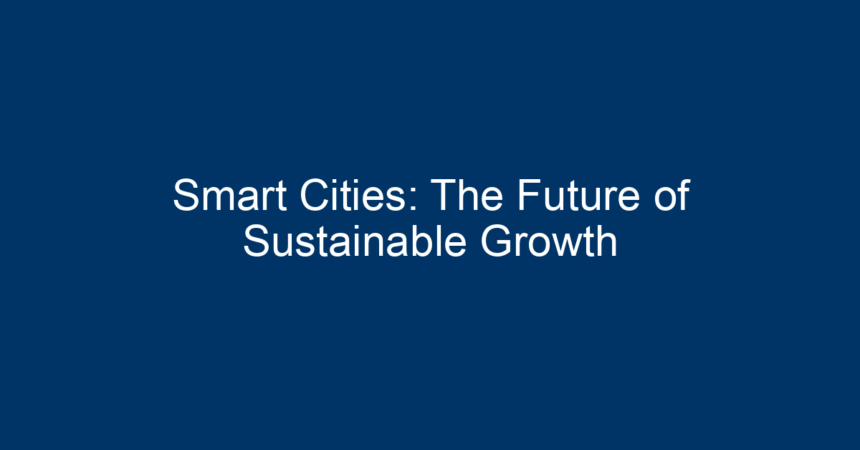As urban populations continue to swell, the demand for innovative solutions to manage infrastructure, services, and resources has never been more pressing. Enter smart cities—urban areas that leverage technology and data to enhance efficiency, sustainability, and the quality of life for their residents. This article explores the concept of smart cities, illuminating their role in sustainable growth, the technologies driving this transformation, and the actionable steps we can take to foster their development.
What Are Smart Cities?
Smart cities integrate digital technology across all areas of a city, enhancing services such as transportation, utilities, and public safety. These urban environments employ sensors, IoT devices, and data analytics to monitor and manage physical assets and resources. The goal is to create a more efficient, livable, and environmentally friendly urban space.
Key Features of Smart Cities
-
IoT Integration:
The Internet of Things (IoT) connects everyday devices to the internet, allowing them to send and receive data. In smart cities, IoT applications range from smart traffic lights that optimize traffic flow to smart meters that provide real-time data on energy consumption. -
Data-Driven Decision Making:
Utilizing big data and analytics enables city planners and administrators to make informed decisions. Insights drawn from data can help in resource allocation, infrastructure development, and enhancing public services. -
Sustainable Practices:
Smart cities focus on sustainability through the use of renewable energy sources, smart waste management systems, and green building initiatives. These practices not only reduce environmental impact but also lower costs in the long run. - Enhanced Connectivity:
With high-speed internet and improved digital communications, smart cities ensure that residents can easily connect to services, information, and each other, fostering greater community engagement.
The Role of Technology in Smart Cities
Technology is the backbone of smart cities, enabling innovations that drive sustainable growth. Here are some key technologies contributing to this transformation:
-
Smart Grids:
A smart grid uses digital technology to monitor and manage the transport of electricity. By enhancing the resilience and efficiency of energy delivery, smart grids can accommodate renewable energy sources, reduce losses, and streamline energy use. -
Intelligent Transportation Systems (ITS):
ITS employs advanced technologies to improve transportation systems. For example, real-time traffic data from sensors can adjust traffic signals, reducing congestion and travel time while lowering emissions. -
Smart Water Management:
Innovative water management systems equipped with sensors and real-time monitoring help manage water usage better. Predictive analytics can prevent leaks, reducing waste and promoting sustainability. - Public Safety Innovations:
Smart cities utilize technology to enhance safety measures, employing CCTV cameras with AI for crime detection and emergency response systems that provide real-time information to first responders.
Sustainable Growth in Smart Cities
Sustainable growth is at the heart of the smart city model, addressing current urban challenges while preserving resources for future generations. Here are some ways smart cities promote sustainability:
-
Energy Efficiency:
The use of smart meters and energy-efficient buildings reduces energy consumption significantly. For instance, smart homes can automatically adjust energy settings based on occupancy, leading to substantial savings and decreased environmental footprints. -
Waste Reduction:
Smart waste management systems can optimize collection routes and schedules based on real-time data, thereby minimizing operational costs and environmental impact. -
Transportation Solutions:
Implementing public transportation that relies on real-time data can lead to higher efficiency in service delivery. Electric buses and shared mobility services promote eco-friendly alternatives to traditional cars. - Urban Green Spaces:
Smart cities prioritize the integration of green spaces, which helps in reducing urban heat islands, improving air quality, and providing residents with recreational areas.
Challenges in Developing Smart Cities
While the potential benefits of smart cities are vast, several challenges must be addressed to facilitate their development:
-
High Implementation Costs:
The initial investment required for smart technologies can be prohibitive for cities with limited budgets. However, the long-term savings from enhanced efficiency often justify these costs. -
Data Privacy Concerns:
With the increased collection of data, concerns about privacy and security are paramount. Establishing stringent data governance frameworks is crucial to ensure that residents’ information is protected. -
Technological Inequity:
Disparities in access to technology can create inequities among residents. Smart cities must prioritize inclusivity, ensuring that all communities benefit from technological advancements. - Regulatory Framework:
The fast-paced nature of technology often outstrips existing regulations. Policymakers need to adapt to the changing landscape, creating supportive environments for smart city initiatives.
Actionable Insights for Policymakers and Citizens
To ensure that the vision of smart cities turns into reality, collaborative efforts from both policymakers and citizens are essential. Here are some actionable steps:
-
Invest in Infrastructure:
Governments should prioritize investments in digital infrastructure, ensuring high-speed internet is accessible to all areas, particularly underserved communities. -
Encourage Public-Private Partnerships:
Collaborations between governmental bodies and private companies can accelerate the development of smart technologies and provide innovative solutions to urban challenges. -
Promote Community Engagement:
Encouraging citizen participation in decision-making and implementation allows for diverse perspectives, fostering solutions that truly reflect community needs. -
Emphasize Education and Training:
Fostering a workforce skilled in technology and data analytics is essential for the successful management and operation of smart cities. - Adopt Sustainable Practices:
Policymakers should incorporate sustainability into all urban planning frameworks, ensuring that new projects align with environmental goals and promote resilience against climate change.
Conclusion
Smart cities represent a transformative approach to urban development, merging technology with sustainability to create efficient and livable environments. As we look towards the future, it’s crucial for all stakeholders—governments, businesses, and residents—to collaborate in making smart cities a reality. By harnessing technology’s potential and prioritizing sustainable practices, we can pave the way for a brighter, greener urban future. Conducting research, fostering partnerships, and embracing innovative solutions will lead us to smart cities that not only enhance our lives today but also ensure a thriving planet for generations to come. The future of sustainable growth is at our fingertips—it’s time to embrace it.




